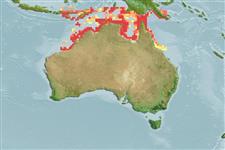Common names from other countries
>
Eupercaria/misc (Various families in series Eupercaria) >
Labridae (Wrasses) > Bodianinae
Etymology: Choerodon: Greek, choiros = a pig + odous = teeth (Ref. 45335); referrring to the prominent anterior canines of the species in this genus (Ref. 116605).
More on author: Ogilby.
Environment: milieu / climate zone / depth range / distribution range
Écologie
marin démersal; profondeur 10 - 40 m (Ref. 90102). Tropical
Western Central Pacific: northwestern Australia (Ref. 3131) and Papua New Guinea (Ref. 6192).
Taille / Poids / Âge
Maturity: Lm ? range ? - ? cm
Max length : 25.0 cm TL mâle / non sexé; (Ref. 3132)
Épines dorsales (Total) : 13; Rayons mous dorsaux (Total) : 7; Épines anales: 3; Rayons mous anaux: 10. Body mostly pale with faint broad dusky bands especially dorsally. A prominent ocellated dark spot present on dorsal fin between last few spines. Body deep at level of dorsal-fin origin (2.3 to 2.6 times in SL). Second prominent anterior canine mostly straight, only slightly curved in large specimens, angled dorsolaterally and sometimes slightly posteriorly.
Adults inhabit flat sandy or weedy areas (Ref. 3131). Found solitary in rubble, silt or sand bottoms (Ref. 90102). Oviparous, distinct pairing during breeding (Ref. 205). A good food fish.
Life cycle and mating behavior
Maturities | Reproduction | Spawnings | Egg(s) | Fecundities | Larves
Oviparous, distinct pairing during breeding (Ref. 205).
Sainsbury, K.J., P.J. Kailola and G.G. Leyland, 1985. Continental shelf fishes of the northern and north-western Australia. An illustrated guide. CSIRO Division of Fisheries Research; Clouston & Hall and Peter Pownall Fisheries Information Service, Canberra, Australia. 375 p. (Ref. 3131)
Statut dans la liste rouge de l'IUCN (Ref. 130435)
CITES (Ref. 128078)
Not Evaluated
Menace pour l'homme
Harmless
Utilisations par l'homme
Outils
Articles particuliers
Télécharger en XML
Sources Internet
Estimates based on models
Preferred temperature (Ref.
115969): 24.7 - 28.8, mean 27.7 (based on 228 cells).
Phylogenetic diversity index (Ref.
82804): PD
50 = 0.5000 [Uniqueness, from 0.5 = low to 2.0 = high].
Bayesian length-weight: a=0.01318 (0.00582 - 0.02984), b=3.05 (2.86 - 3.24), in cm Total Length, based on LWR estimates for this (Sub)family-body shape (Ref.
93245).
Niveau trophique (Ref.
69278): 3.4 ±0.4 se; based on size and trophs of closest relatives
Résilience (Ref.
120179): Milieu, temps minimum de doublement de population : 1,4 à 4,4 années (Preliminary K or Fecundity.).
Fishing Vulnerability (Ref.
59153): Low vulnerability (15 of 100).
